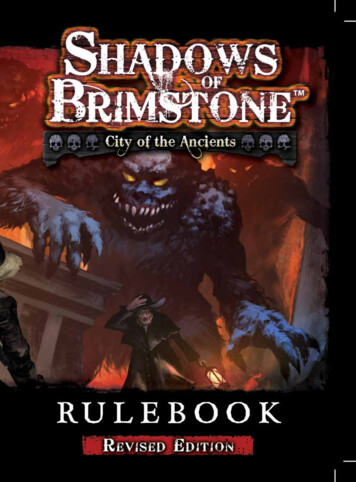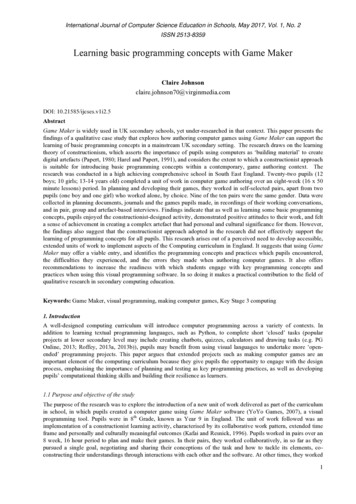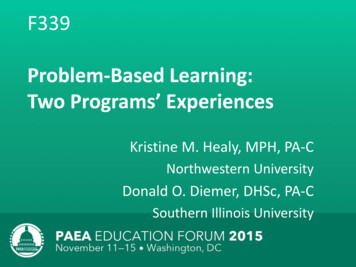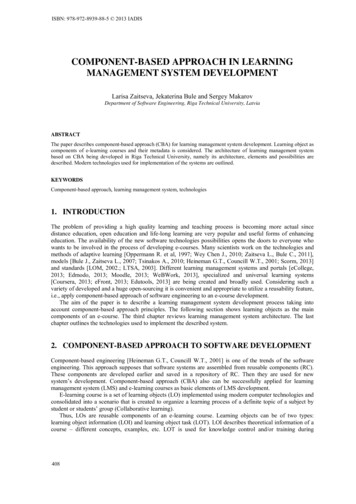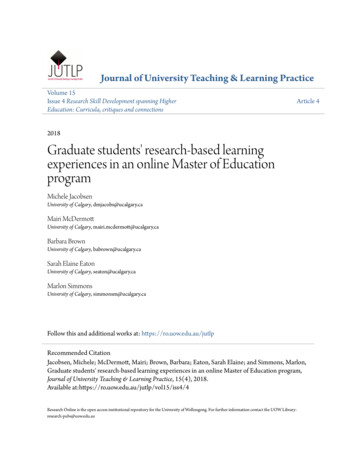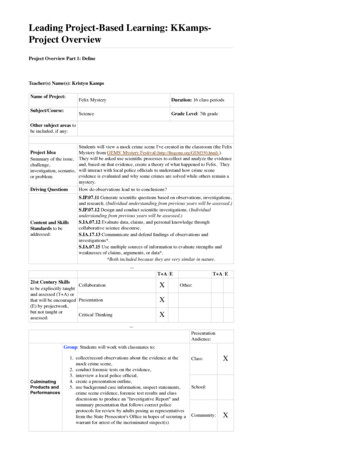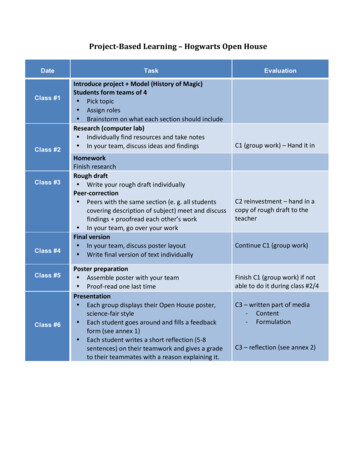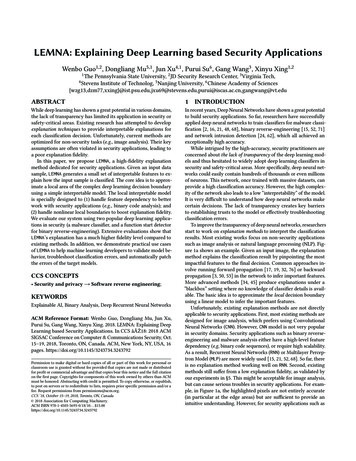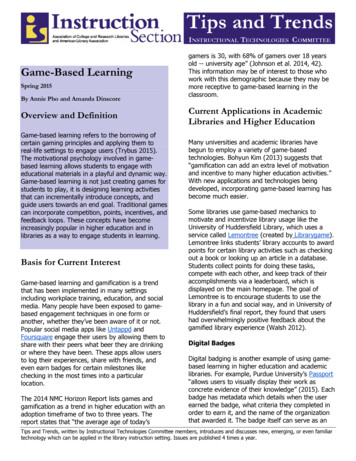
Transcription
Game-Based LearningSpring 2015By Annie Pho and Amanda DinscoreOverview and DefinitionGame-based learning refers to the borrowing ofcertain gaming principles and applying them toreal-life settings to engage users (Trybus 2015).The motivational psychology involved in gamebased learning allows students to engage witheducational materials in a playful and dynamic way.Game-based learning is not just creating games forstudents to play, it is designing learning activitiesthat can incrementally introduce concepts, andguide users towards an end goal. Traditional gamescan incorporate competition, points, incentives, andfeedback loops. These concepts have becomeincreasingly popular in higher education and inlibraries as a way to engage students in learning.Basis for Current InterestGame-based learning and gamification is a trendthat has been implemented in many settingsincluding workplace training, education, and socialmedia. Many people have been exposed to gamebased engagement techniques in one form oranother, whether they’ve been aware of it or not.Popular social media apps like Untappd andFoursquare engage their users by allowing them toshare with their peers what beer they are drinkingor where they have been. These apps allow usersto log their experiences, share with friends, andeven earn badges for certain milestones likechecking in the most times into a particularlocation.The 2014 NMC Horizon Report lists games andgamification as a trend in higher education with anadoption timeframe of two to three years. Thereport states that “the average age of today’sgamers is 30, with 68% of gamers over 18 yearsold -- university age” (Johnson et al. 2014, 42).This information may be of interest to those whowork with this demographic because they may bemore receptive to game-based learning in theclassroom.Current Applications in AcademicLibraries and Higher EducationMany universities and academic libraries havebegun to employ a variety of game-basedtechnologies. Bohyun Kim (2013) suggests that“gamification can add an extra level of motivationand incentive to many higher education activities.”With new applications and technologies beingdeveloped, incorporating game-based learning hasbecome much easier.Some libraries use game-based mechanics tomotivate and incentivize library usage like theUniversity of Huddersfield Library, which uses aservice called Lemontree (created by Librarygame).Lemontree links students’ library accounts to awardpoints for certain library activities such as checkingout a book or looking up an article in a database.Students collect points for doing these tasks,compete with each other, and keep track of theiraccomplishments via a leaderboard, which isdisplayed on the main homepage. The goal ofLemontree is to encourage students to use thelibrary in a fun and social way, and in University ofHuddersfield’s final report, they found that usershad overwhelmingly positive feedback about thegamified library experience (Walsh 2012).Digital BadgesDigital badging is another example of using gamebased learning in higher education and academiclibraries. For example, Purdue University’s Passport“allows users to visually display their work asconcrete evidence of their knowledge” (2015). Eachbadge has metadata which details when the userearned the badge, what criteria they completed inorder to earn it, and the name of the organizationthat awarded it. The badge itself can serve as anTips and Trends, written by Instructional Technologies Committee members, introduces and discusses new, emerging, or even familiartechnology which can be applied in the library instruction setting. Issues are published 4 times a year.
incentive for students to engage in learningactivities, and it allows for external stakeholders toverify the skills students have learned.Portland State University librarian Emily Ford alsouses digital badges in a community health programto acknowledge undergraduates’ creativity andcritical thinking skills. The badges offer studentsboth recognition and certification of skills that maynot otherwise be evaluated in the traditionalclassroom. Additionally, badges add an element offun and an opportunity for students to take pride intheir accomplishments in a highly visible way.According to the MacArthur Foundation (2015),digital badges are “designed to make visible andvalidate learning in both formal and informalsettings, and hold the potential to help transformwhere and how learning is valued.” Openlyavailable tools like Credly allow for anyone to signup for an account and earn, issue, and displaydigital badges. The learning activities that studentscomplete to earn these badges can be very flexible,making it easy for academic libraries to adopt themfor their own learning objectives.Scavenger HuntsScavenger hunts are another example of a playful,game-based learning activity for students toaccomplish a set of tasks and learn about thelibrary. These can be done using simple paperforms or mobile applications. North Carolina StateUniversity uses a mobile scavenger hunt to orientnew students to their library. Students form teams,and use an iPod Touch to take pictures and answerquestions about the library. In contrast to atraditional library tour, this scavenger hunt allowsstudents to collaborate with each other, competeagainst other teams, and learn about what thelibrary has to offer while using familiar technologytools. The University of Arizona Library usedSCVNGR, a now defunct mobile app, forasynchronous library orientations, which allowedstudents to explore the library without having todepend on staff to oversee the activities (Pagowsky2013). Appalachian State University has alsocreated their own virtual tour/scavenger hunt gamefrom scratch that orients their students to thelibrary. For libraries without in-house programmers,other mobile scavenger hunt apps like Scavify orSocial Scavenger allow organizations to easilycreate scavenger hunts for groups, with thepotential for asynchronous exploration.Applications in Academic LibraryInstructionLibrarians who provide instruction are alwayslooking for new ways to engage learners both inperson and online. Game-based learning offersstudents the opportunity to explore and experimentwith new research skills without fear of failure orbad grades. It also offers opportunities forincreased student engagement by adding a senseof fun to their library instruction experience.In the last decade, several libraries have dedicatedconsiderable time and resources to thedevelopment of their own information literacygames. Often grant-funded, some of these gamesmay no longer be in active development or offersupport to libraries who want to use them. Oneexample, the Bibliobouts Project, created an onlinesocial game that taught information literacy skillsas students worked through the process ofcompleting an assignment that required researchand writing using the social research and citationmanagement tool Zotero (Markey, Leeder, andTaylor 2012). Quarantined: Axl Wise and theInformation Outbreak is a single-player role-playinggame developed by librarians at Arizona State thatsimulates the complexities of selecting, using,evaluating, and synthesizing sources for research.Gaming Against Plagiarism is an open source set ofthree mini-games developed by librarians at theUniversity of Florida with grant support from theNational Science Foundation. Michelle FossLeonard, one of the project’s principalinvestigators, stated in an email that the gameshave a wide variety of applications, and arecurrently used in credit courses on researchintegrity, library instruction workshops, and as partof a remediation process for students with honorcode violations.It is not necessary for librarians to embark onlarge-scale game development projects toincorporate gaming into their instruction, however.Gamification, “the addition of game-like-elements,also called game mechanics, in non-game settings,”can provide opportunities for engagement,flexibility, competition, and collaboration.Gamification can include the incorporation of
points, levels or even just time restrictions whichencourage students to compete with themselvesand value their own achievements. Social elementscan also be used that encourage competitionand/or cooperation with other students (Huang andSoman 2013, 13). Even traditional board and cardgames can be used to engage learners. AndrewWalsh, a librarian at the University of Huddersfield,developed SEEK, a card game designed to beplayed in class. It takes about 10-20 minutes, andcovers topics such as plagiarism, credibility ofsources, and finding key words.These and many other games and gamificationprojects demonstrate a growing interest inexperimentation and integration of games intoinformation literacy instruction. Any librarianconsidering developing or integrating games intotheir instruction should look at success stories aswell as projects that were either unsuccessful orshort-lived. Additionally, as many of the large-scaleonline games are open-source, there is opportunityto adapt and build upon those that already exist.Potential ValueGame-based learning provides an opportunity forlibrarians to incorporate active learning into theirinstruction sessions, promote students’ interest andengagement, and provide immediate feedback onperformance. There is also a significant amount ofresearch that suggests that game-based learningcan increase student learning.James Paul Gee, a prominent scholar in the field ofgame-based learning, describes some of thelearning principles that games utilize, including theopportunity to experience the world through newroles and identities and the potential to encouragereflective practice by having players engage in acycle of probing, hypothesizing, probing again, andrethinking their strategies (2003, 208-209).Because the experience of the game is unique foreach player and dependent upon their actions anddecisions, gamers are allowed to becomeproducers, rather than just consumers, of content(195).Gee states that “good video games incorporategood learning principles, principles supported bycurrent research in cognitive science” (2005, 34).Significantly, games provide an opportunity forlearners to experiment, take risks, and learn fromfailure without fear of real-life consequences (Gee2003, 62). Games also allow players to developskills incrementally through practice and challengeplayers to push themselves without feeling like thetasks are insurmountable (71). By incorporatinggame-based learning in the in-person and onlineclassroom, these attributes can be leveraged bylibrarian educators to create more compellinglearning experiences.Finally, games offer a unique opportunity to assessstudent learning. Higher-order thinking skills suchas critical thinking and problem solving can beevaluated by observing students as they playgames and by looking at performance data, anassessment strategy referred to as “stealthassessment” (Kaya 2010).Potential HurdlesWhile there are many benefits to using game-basedlearning strategies in our teaching, there are alsosignificant challenges. First and foremost, it isimportant to consider whether the technology orgame is being used for its own sake or if it actuallyimproves learning. Instructors should consider theirstudents’ proficiency with technology so that thetechnology itself doesn’t become a barrier tolearning. Additionally, for those who want to createtheir own games, it is worth noting that, even forexperienced game designers, creating a game isdifficult. What is even more difficult is making agood game--one that effectively teaches andengages players. Librarians who want to learnabout game design are encouraged to exploreresources that examine e-learning design, as manyof the same concepts can be applied to educationalgame development.Game-development can require significant time andresources. Librarians who are consideringdeveloping their own game should think about howthe project will be maintained. A gamedevelopment project must be well-planned andhave support from colleagues and administrators. Ifit is viewed as a short-term project and investmentis limited, it is likely that the project will not besupported in the long-term.While many of these hurdles are most significantwith large game development projects, they are
also worth considering for smaller-scaleimplementation of game-based learning. Thepotential benefits must be weighed against thetime and resources required even if you are onlyincorporating a ready-made game, or gameelements, into your library instruction sessions.Amy Hofer (2013) described her experienceincorporating the game Bibliobouts into her forcredit online information literacy course and theconsiderable technological challenges her studentsfaced. She then adapted a lower-tech game for usein the same class which she felt was much moresuccessful, though not without its own challenges.Learning from other librarians’ experiences anddeveloping an informed and well-planned approachcan do much to alleviate some of the hurdles toincorporating games into information literacyinstruction.———. 2005. “Good Video Games and GoodLearning.” Phi Kappa Phi Forum 85(2): 3337. b/GoodVideoGamesLearning.pdf.ConclusionHuang, Wendy Hsin-Yuan, and Dilip Soman. 2013.Game-based learning can be used in a variety ofways to enhance library instruction, and researchacross disciplines supports its effectiveness in theclassroom. When designed with learning principlesin mind, games can increase student motivation,engagement, and learning.Librarians may use board or card games like SEEKto add an element of fun, cooperation, andcompetition to face-to-face classes. Gamificationstrategies, like the incorporation of digital badgesand virtual scavenger hunts, can offer a way forstudents to obtain visible recognition for skills andknowledge and can potentially reinforceengagement and participation. Librarians can alsouse commercial or open-source games, or createtheir own games, for use in library instruction.While much more labor- and resource-intensive,developing a new game can be successful iflibrarians collaborate with fellow educators andinstructional designers to leverage expertise ineducational technology and game development.It is clear that game-based learning offers anexciting opportunity to promote engagement andlearning in library instruction. Increased access tothe technology that allows us to create and accessgames, as well as the relatively recent popularity ofgamification in our everyday lives, have enabled usto experiment with these technologies andapplications in interesting and innovative ways.ReferencesGee, James Paul. 2003. What Video Games Have toTeach Us About Learning and Literacy. NewYork: Palgrave Macmillan.Hofer, Amy R. 2013. "Giving Games the Old CollegeTry," In the Library with the Lead Pipe(blog). December 18. ving-games-the-old-college-try/.A Practitioner's Guide to Gamification ofEducation. Research Reports Series,Behavioural Economics in Action. RotmanSchool of Management, University ofToronto. December ationDec2013.pdf.Johnson, Larry, Samantha Adams Becker, VictoriaEstrada, and Alex Freeman. 2014. NMCHorizon Report: 2014 Higher EducationEdition. Austin: The New Media on-report-he-EN-SC.pdf.Kaya, Travis. 2010. “A ‘Stealth Assessment’ Turnsto Video Games to Measure Thinking Skills.”The Chronicle of Higher Education,November 7. urns/125276/.Kim, Bohyun. 2013. "Gamification." Keeping UpWith. ACRL, May. http://www.ala.org/acrl/publications/keeping up with/gamification.MacArthur Foundation. 2015. “Digital Badges.”Accessed April 6. http://www.macfound.org/programs/digital-badges.
Markey, Karen, Chris Leeder, and Charles L. Taylor.2012. "Playing Games to Improve theQuality of the Sources Students Cite in TheirPapers." Reference & User ServicesQuarterly 52(2): 123-135.Pagowsky, Nicole. 2013. “Taking a Trek withSCVNGR: Developing Asynchronous, MobileOrientations and Instruction for Campus.”ACRL TechConnect Blog, May 13.http://acrl.ala.org/techconnect/?p 3342.Purdue University. 2015. “Passport.” Accessed April6. , Jessica. 2015. “Game-Based Learning:What it is, Why it Works, and Where it’sGoing.” New Media Institute. Accessed April6. it-is-why-it-works-and-where-its-going.html.Walsh, Andrew. 2012. “Final Report on Lemontree.”University of Huddersfield. cts11/Lemon tree final report for website.docx.Further ReadingsFerrara, John. 2012. Playful Design: Creating GameExperiences in Everyday Interfaces.Brooklyn: Rosenfeld Media.Kapp, Karl M. 2012. The Gamification of Learningand Instruction: Game-based Methods andStrategies for Training and Education. SanFrancisco: Pfeiffer.McGonigal, Jane. 2011. Reality is Broken: WhyGames Make us Better and How They CanChange the World. New York: PenguinPress.
Game-based learning provides an opportunity for librarians to incorporate active learning into their instruction sessions, promote students’ interest and engagement, and provide immediate feedback on performance. There is also a significant amount of research that suggests that game-based learning
